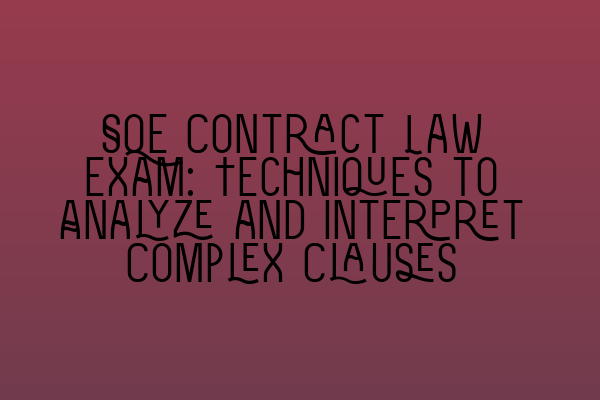SQE Contract Law Exam: Techniques to Analyze and Interpret Complex Clauses
Contract law is a fundamental aspect of legal practice, requiring solicitors to have a thorough understanding of contract clauses and their implications. Within the context of the SQE contract law exam, it is essential to develop strong analytical and interpretive skills to effectively navigate complex clauses. In this article, we will explore various techniques that can help aspiring solicitors excel in this exam.
1. Break down the clause
When faced with a complex clause, the first step is to break it down into its constituent parts. Identify the key terms and phrases, noting any definitions and interpretations provided within the clause itself or elsewhere in the contract. Pay attention to any conditional or contingent language, as these can significantly affect the obligations and rights of the parties involved.
For example, if the clause contains the phrase “subject to”, it indicates that the provision is conditional upon certain circumstances or actions. Understanding these nuances is crucial for accurate analysis and interpretation.
2. Consider the context
Contracts do not exist in isolation but are part of a broader commercial or legal context. It is essential to consider the purpose of the contract, the relationship between the parties, and any external factors that may impact the interpretation of the clause.
For instance, if the contract is for the sale of goods, you may need to refer to relevant legislation (such as the Sale of Goods Act 1979 in the UK) to determine the rights and obligations of the parties. By considering the context, you can ensure your analysis aligns with the overarching legal framework.
3. Analyze the language used
The language used in contractual clauses can be technical and precise. Pay attention to the specific wording and the ways in which certain words or phrases may be defined within the contract. Consider whether any terms have been expressly defined or assigned meaning elsewhere in the document.
It is also important to scrutinize the use of mandatory or permissive language. For instance, phrases such as “shall” often impose obligations, while “may” suggests a discretionary power. Identifying these distinctions can help you accurately interpret the intent of the clause.
4. Examine the consequences
Analyzing the consequences of a clause is vital to understanding its impact. Consider the likely outcomes and effects of each interpretation, and determine whether they align with the broader aims and objectives of the contract.
Additionally, examine any remedies, indemnities, or limitations of liability outlined in the clause. These provisions can significantly influence the bargaining power and risk allocation between the parties.
5. Seek guidance from precedents and case law
Precedents and case law provide valuable guidance and insight when interpreting complex clauses. By researching relevant legal precedents, you can gain a deeper understanding of how particular contractual provisions have been interpreted and applied in practice.
Make use of relevant legal resources, such as legal journals, textbooks, and databases, to identify precedents and case law that support your interpretation. Additionally, refer to professional bodies and legal associations for guidance on best practices and industry standards.
Conclusion
In the SQE contract law exam, the ability to analyze and interpret complex contractual clauses is crucial for success. By breaking down clauses, considering the context, analyzing the language used, examining the consequences, and seeking guidance from precedents and case law, aspiring solicitors can develop the skills needed to navigate this aspect of contract law effectively.
To further your understanding of the legal field and enhance your career prospects, we recommend reading the following related articles:
- Exploring Solicitor Salaries in the UK: Average Earnings and Factors Affecting Income
- Securing Training Contracts: A Roadmap to Becoming a Solicitor
- Mentorship for Aspiring Solicitors: Nurturing Talent in the Legal Field
- Legal Challenges and Pitfalls: Navigating the Complexities of the Legal System
- The GDL (Graduate Diploma in Law): A Pathway to Becoming a Solicitor
